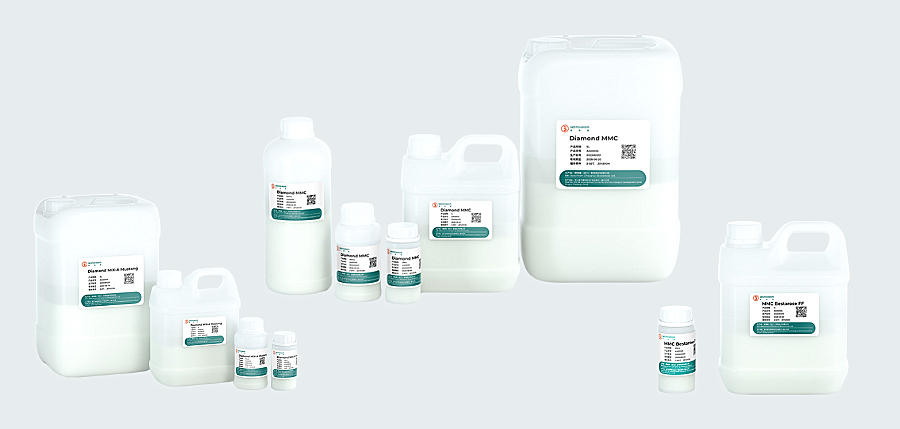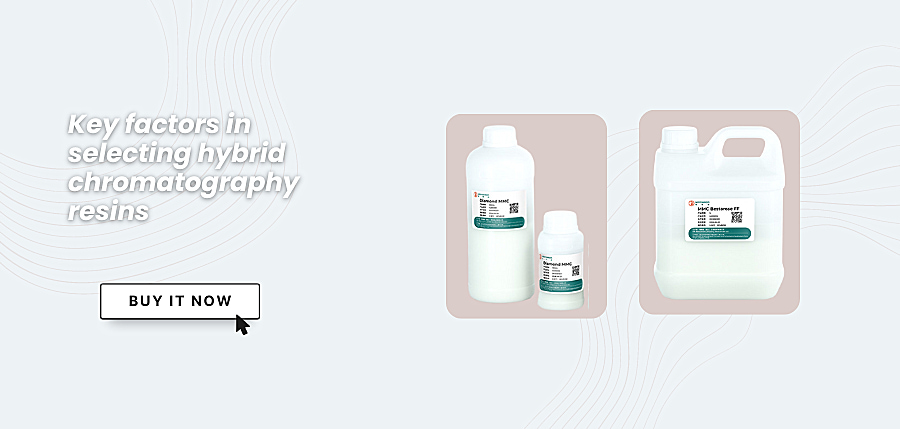


Mixed-mode chromatography is an innovative chromatography method which can simultaneously provide different interactions for the binding between ligands and macro-biomolecules. Dominant interactions in this category include electric charge interaction, hydrophobic interaction and hydrogen bond. Compared with single-mode methods, mixed-mode chromatography can achieve elution by changing pH, conductivity or adopting pH-salt double gradient strategy, which expands application conditions, providing effective solutions to challenges faced in processing and purification practice.

A hybrid chromatography resin is a type of resin used in chromatography that combines the properties of two different types of materials, typically organic and inorganic components, to provide better performance, such as enhanced binding capacity, stability, and selectivity for specific molecules during separations. Mixed mode resins, a subset of hybrid resins, are based on ligand functionalized media with various chromatographic interactions, making them very versatile.
These resins enable you to remove process impurities in a single column step, saving time. They combine different modes of protein separation, improving selectivity and allowing for salt-tolerant adsorption of target proteins. Mixed mode resins facilitate binding of desired proteins without dilution or salt addition, making them ideal for direct capture steps and chromatographic polishing in downstream processes.
Hybrid resins can be categorized based on their composition and functional properties:
Inorganic-Organic Hybrid Resins: These resins combine inorganic materials like silica or zirconia with organic polymers to enhance mechanical strength and chemical stability.
Mixed-Mode Hybrid Resins: These resins possess multiple types of functional groups, allowing them to interact with target molecules through various mechanisms, such as ion exchange, hydrophobic interactions, and hydrogen bonding.
Surface-Modified Hybrid Resins: These resins have an organic polymer backbone with inorganic surface modifications to improve specific properties like pore size distribution or binding affinity.

1. Application Requirements
Before choosing a hybrid chromatography resin, it is essential to understand the specific requirements of your application. Consider the following:
Target Molecule: The nature of the molecule you wish to purify (e.g., protein, peptide, nucleic acid) significantly impacts the choice of resin.
Purity Levels: The required purity levels will dictate the resin’s selectivity and binding capacity.
Scale of Operation: Determine whether you need the resin for analytical, preparative, or industrial-scale processes.
2. Resin Chemistry and Structure
The chemistry and structure of the hybrid chromatography resin play a critical role in its performance. Key aspects to consider include:
Functional Groups: Different resins offer various functional groups, such as anionic or cationic exchangers, which interact with target molecules differently.
Matrix Composition: The base material of the resin, often agarose or polystyrene, affects its physical and chemical stability.
Pore Size and Distribution: The pore size influences the resin’s ability to separate molecules based on size exclusion principles.
3. Binding Capacity and Selectivity
Binding capacity refers to the amount of target molecule the resin can bind under specific conditions. High binding capacity is desirable for efficient purification, but it must be balanced with selectivity. Selectivity is the resin’s ability to distinguish between the target molecule and impurities.
4. Flow Rates and Pressure Limits
Consider the operational parameters such as flow rates and pressure limits. The chosen resin should support the required flow rates without compromising separation efficiency. Additionally, it should withstand the operational pressures of your chromatographic system to ensure longevity and performance consistency.
1. Cost-Effectiveness
Evaluate the cost-effectiveness of the resin by considering not only the initial purchase price but also the longevity and regeneration capabilities. High-performance resins that can be reused multiple times may offer better long-term value.
2. Supplier Support and Documentation
Reliable technical support and comprehensive documentation from the supplier are invaluable. This includes detailed protocols, troubleshooting guides, and performance data to ensure successful implementation.
3. Environmental Impact
Consider the environmental impact of the resin, including its production, use, and disposal. Environmentally friendly resins with lower carbon footprints and minimal hazardous waste generation are preferable for sustainable practices.
Can Different Resins Be Mixed?
Yes, different resins can be mixed, but it's important to consider their compatibility. Mixing different types of resins can affect the properties of the final product, including its strength, durability, and chemical resistance. Testing and careful formulation are crucial to ensure the desired characteristics are achieved.
What Are the Benefits of Mixed Mode Chromatography?
Mixed mode chromatography combines different separation mechanisms (e.g., ionic and hydrophobic interactions) in one column, providing several benefits:
Versatility: Effective for a wide range of molecules.
Efficiency: Can separate complex mixtures more effectively.
Selectivity: Enhanced ability to target specific molecules.
Cost-effective: Reduces the need for multiple purification steps.
How Does Mixed Mode Chromatography Work?
Mixed mode chromatography works by utilizing multiple interaction types within a single column. As the sample passes through the column, different molecules interact with the resin in various ways (e.g., ionic and hydrophobic interactions). This combination allows for the effective separation of complex mixtures, as different molecules will be retained and eluted at different rates based on their unique properties and interactions with the resin.
Selecting the right hybrid chromatography resin involves a thorough understanding of your application requirements, resin characteristics, and operational parameters. By considering factors such as target molecule, binding capacity, flow rates, and buffer compatibility, you can optimize your chromatographic separations and achieve superior results.

.png)

